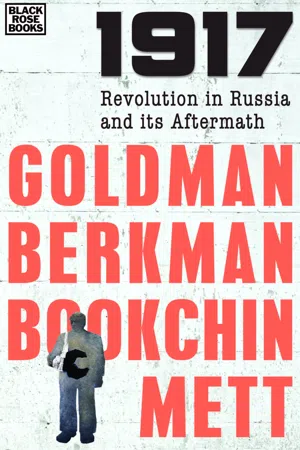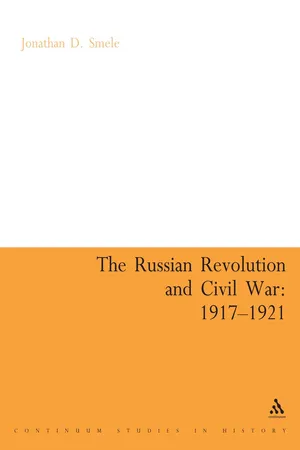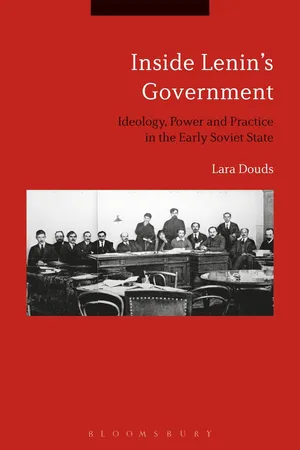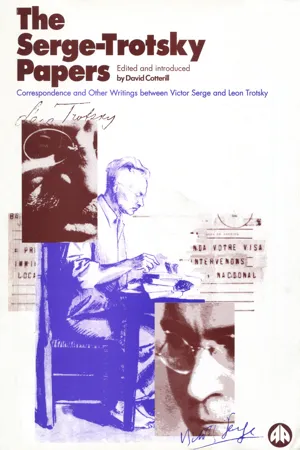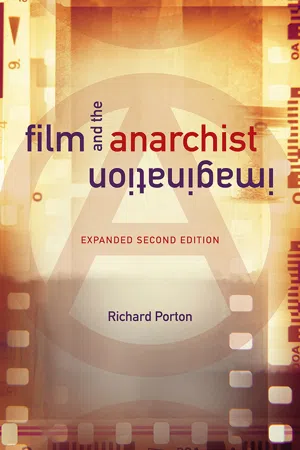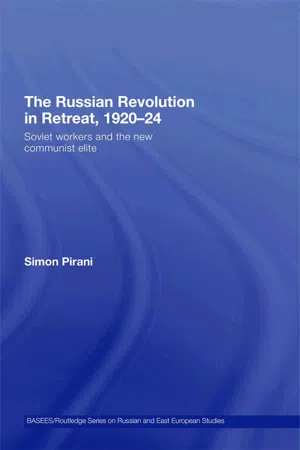History
Kronstadt Rebellion
The Kronstadt Rebellion was a 1921 uprising by sailors and workers in the Kronstadt naval fortress against the Bolshevik government in Russia. The rebels demanded greater political freedom, an end to the one-party system, and the release of political prisoners. The rebellion was eventually crushed by the Red Army, and many of the rebels were executed or sent to labor camps.
Written by Perlego with AI-assistance
Related key terms
1 of 5
9 Key excerpts on "Kronstadt Rebellion"
- eBook - PDF
1917
Revolution in Russia and its Aftermath
- Emma Goldman, Alexander Berkman, Murray Bookchin, Ida Mett(Authors)
- 2019(Publication Date)
- Black Rose Books(Publisher)
317 THE KRONSTADT UPRISING 318 INTRODUCTION BY MURRAY BOOKCHIN O n March 1, 1921, the Kronstadt naval base on Kotlin Island, some twen-ty-five miles offshore from Petrograd, adopted a fifteen-point program of political and economic demands—a program in open defiance of the Bol-shevik Party’s control of the Soviet state. Almost immediately the Bolsheviks denounced the uprising as a “White Guard plot,” ostensibly another in the series of counterrevolutionary con-spiracies that had beleaguered the Soviet regime during the three proceed-ing years of civil war. Less than three weeks later, on March 17, Kronstadt was subdued in a bloody assault by select Red Army units. The Kronstadt uprising, to all appearances, had been little more than a passing episode in the bitter history of the civil war. We can now say, however, that the Kronstadt uprising marked the defini-tive end of the Russian Revolution itself. Indeed, the character and impor-tance of the uprising were destined to become issues of acrimonious dispute within the international Left for years to come. Today, although an entirely new generation of revolutionaries has emerged, a generation almost totally uninformed of the events, “the problem of Kronstadt” has lost none of its relevance and poignancy. The Kronstadt uprising posed very far-reaching issues: the relationship between the so-called “masses” and the parties which profess to speak in their name, and the nature of the social system in the modern Soviet Union. The Kronstadt uprising, in effect, remains as a lasting challenge to the Bolshevik concept of a party’s historical function and the notion of the Soviet Union as a “workers’” or “socialist” state. The Kronstadt sailors were no ordinary military body. They were the fa-mous “Red Sailors” of 1905, 1917, and the civil war. - eBook - PDF
The Russian Revolution and Civil War 1917-1921
An Annotated Bibliography
- Jonathan Smele(Author)
- 2006(Publication Date)
- Continuum(Publisher)
3319 Berkman, A. The Kronstadt Rebellion . Berlin: Der Syndicalist, 1922. 42 pp. In this impassioned piece the noted anarchist voices his disgust at the Bolsheviks' crushing of the rebellion ± an event he observed from Petersburg. 3320 Ciliga, A. The Kronstadt Revolt . London: The Freedom Press, 1942. 16 pp. A bitter refutation of Trotsky's articles of 1938, from the anarchist point of view. 3321 Daniels, R. V. `The Kronstadt Revolt of 1921: A Study in the Dynamics of Revolution', Slavic Review Vol. 10 (1951), No. 4, pp. 241±254. The author explains the revolt as `symptomatic of the general state of internal crisis in Soviet Russia' and interprets its merciless suppression by Lenin as fulfilling, in peasant Russia, Engels's prophecy that `the worst thing that can befall the leader of an extreme party is to be compelled to take over a government in an epoch when the movement is not yet ripe for the domination of the class which he represents and for the realization of the measures which that domination would imply'. 3322 Hunter, A. `The Kronstadt Revolt of 1921 and Stefan Petrichenko', Ukrainian Quarterly Vol. 23 (1967), No. 3, pp. 255±263. Disappointingly, this article is not an analysis of the Ukrainian sailor's role in the revolt, but a (predictably anti-Soviet) general account of the events of February to March 1921. 3323 Katkov, G. `The Kronstadt Rising', St Antony's Papers Vol. 6/ Soviet Affairs No. 2 (1959), pp. 9±54. 3314 . 18 Popular Hostility to Soviet Rule 336 This extensive survey of the published materials available at the time (authored by an e migre historian of right-wing persuasions) is a damning indictment of the suppression of the revolt. Included are many useful bibliographical references to early Soviet works. 3324 Marie, J.-J. `Le dernier survivant de Cron-stadt', L'Histoire No. 142 (1991), pp. 64±66. A brief discussion of how the rebellion was portrayed in the memoirs of Ivan Ermolaev which were published in Russia in 1989. - eBook - PDF
- Jean Grondin, Joel Weinsheimer(Authors)
- 2002(Publication Date)
- Yale University Press(Publisher)
F ROM K RONSTADT TO N OVOCHERKASSK 215 BOLSHEVISM began its bloodsoaked harvest right after the coun-terrevolutionary coup of 1917 . Its more brazen methods of violence were worked out at the expense of the sailors and soldiers of Kron-stadt. And it went on from there, from Kronstadt and Tambov, through hundreds of peasant uprisings, through camps and execu-tions, prisons and insane asylums. For decades, Soviet historiography portrayed the bloody events in Kronstadt in the spring of 1921 as a mutiny organized by White Guards, SRs, Mensheviks, and Anarchists, with the active support of foreign intelligence services, in particular the French. It was asserted that the Kronstadt Rebellion, aimed at the overthrow of the Soviet government, was joined by the sailors of only a few ships and by a small group of soldiers in the garrison. It was emphasized that the leaders of the Party and the state did everything they could to avoid bloodshed and that only after all peaceful appeals to the sailors and soldiers were rejected was armed force employed. It was given out that, after the fortress was captured, only the more active members of the mutiny, primarily White officers, were sentenced to death and that no other repressions followed. Documents show that all this was a contemptible lie on the part of the Bolshevik authorities. The Kronstadt events have their bloody prelude. From Kronstadt to Novocherkassk During the fratricidal civil war, a large part of the peasantry and working class, while still giving support to the Soviet government, protested strenuously against the Bolsheviks’ monopoly on power. In the cities, as well, a highly explosive situation developed. There was a food shortage. Many plants and factories were shutting for lack of fuel and raw materials, and workers were being thrown out into the street. The situation was particularly bad in the major in-dustrial centers, especially in Moscow and Petrograd. - eBook - PDF
Behind the Front Lines of the Civil War
Political Parties and Social Movements in Russia, 1918-1922
- Vladimir N. Brovkin(Author)
- 2015(Publication Date)
- Princeton University Press(Publisher)
From this m om ent on the Kronstadt sailors were on the defensive. Itwas only a matter of time and casualties before they would be overrun. T he content and political message of popular appeals in Petrograd and Kronstadt changed considerably in the course of only two weeks. If, in the last days of February, workers’ resolutions sounded like lists of grievances focusing primarily on economic hardships, two weeks later they expressed an outright rejection of Com m unist rule and Soviet power as such. In a leaflet printed clandestinely despite arrests, the Petrograd Assembly of Plenipotentiaries ap pealed to the population: You all have read appeals and orders of the government. You all understood their meaning. They respond with guns to the lawful demands o f the people. Guns are thundering over Petrograd. It is inadmissible to wait any longer. It is time to act. The People themselves must decide their fate. They themselves must overthrow the yoke of Bolshevism. Everyone without exception must take part in this struggle. The Workers have already risen. T he villages are in flames. Kronstadt rose in rebellion to support Petrograd workers. N ow Petrograd workers must rise to support Kronstadt sailors . 27 The revolutionary press in Kronstadt echoed similar themes. The Bolsheviks were referred to as a party that had usurped power, “by methods of force, murder, treason, and vengeance on the families of those who had risen in revolt.” T he Bolsheviks had promised liberty and given workers Cheka terror instead. They had talked about a worker-peasant alliance but robbed the coun tryside. T he editorial continued: “But the moral yoke of Com m unism is even more criminal. They have enchained the whole spiritual life of the laborers, forcing them to think like them. Now the people are convinced that they have betrayed the principles of socialism, and they will put an end to this tyranny. - eBook - PDF
Inside Lenin's Government
Ideology, Power and Practice in the Early Soviet State
- Lara Douds(Author)
- 2018(Publication Date)
- Bloomsbury Academic(Publisher)
The Tenth Party Congress assembled in Moscow in March 1921 under a dark shadow. The recent peasant rebellion in Tambov frightened Soviet leaders, but it was the Kronstadt naval revolt in March 1921 that gave the regime its greatest scare. Kronstadt, a naval base on an island off the coast of Petrograd, had initially been ‘the pride and joy of the revolution’, training the guns of the battleship Aurora on the Winter Palace and crushing opposition to the dissolution of the Constituent Assembly the following year. Yet by 1921 16,000 soldiers and workers there had signed a petition calling for ‘Soviets without Bolsheviks’: freely elected Soviets, and freedoms of speech, press 126 Inside Lenin’s Government and association. Lenin’s government reacted brutally, dissolving the Kronstadt Soviet, executing several hundred ringleaders and expelling over 15,000 sailors from the fleet. Though the rebellions were mercilessly crushed, Lenin now com-pared the Communist state to a man ‘beaten to within an inch of his life’ and described Kronstadt as ‘the flash which lit up reality better than anything else’. Order, economic restoration and conciliation were the new priorities. The head- line resolution of the congress was the replacement of food requisitioning by a tax in kind, abandoning the central plank of ‘War Communism’ and laying the foundations of the New Economic Policy by allowing the peasants to sell their surplus on the free market once the tax was paid. Fearful that the delegates would denounce the tax as a restoration of capitalism, Lenin insisted that it was needed to tackle famine, quell the peasant uprisings and build a new alliance with the peasantry. As well as revolts and rebellions from workers, peasants, soldiers and sail-ors, opposition also arose within the party itself during this time. - eBook - ePub
The Serge Trotsky Papers
Correspondence and Other Writings Between Victor Serge and Leon Trotsky
- David Cotterill(Author)
- 1994(Publication Date)
- Pluto Press(Publisher)
63 and LD Trotsky on Kronstadt. This great subject merits being taken up again thoroughly and the two studies that you have published are far, very far, from exhausting it. In the very first place, I am surprised to see our comrades Wright and LD Trotsky employ a reasoning which, it seems to me, we ought to beware of and refrain from. They record that the drama of Kronstadt, 1921, is evoking commentaries at once from the Social Revolutionists, the Mensheviks, the anarchists and others; and from this fact, natural in an epoch of ideological confusion, of the revisions of values, of the battles of sects, they deduce a sort of amalgam. Let us be distrustful of amalgams and of such mechanical reasoning. They have been too greatly abused in the Russian revolution and we see where it leads. Bourgeois liberals, Mensheviks, anarchists, revolutionary Marxists consider the drama of Kronstadt from different standpoints and for different reasons, which it is well and necessary to bear in mind, instead of lumping all the critical minds under a single heading and imputing to all of them the same hostility towards Bolshevism.The problem is, in truth, much vaster than the event of Kronstadt, which was only an episode. Wright and LD Trotsky support a highly simple thesis: that the Kronstadt uprising was objectivly counter-revolutionary and that the policy of Lenin’s and Trotsky’s Central Committee at that time was correct before, during and after. Correct this policy was, on an historic and moreover grandiose scale, which permitted it to be tragically and dangerously false, erroneous, in various specific circumstances. That is what it would be useful and courageous to recognise today instead of affirming the infallibility of a general line of 1917–1923. There remains broadly the fact that the uprisings of Kronstadt and other localities signified to the party the absolute impossibility of persevering on the road of War Communism. The country was dying of bitter-end starification. Who then was right? The Central Committee which clung to a road without issue or the masses driven to extremities by famine? It seems to me undeniable that Lenin at that time committed the greatest mistake of his life. Need we recall that a few weeks before the establishment of the NEP, Bukharin published a work on economics showing that the system in operation was indeed the first phase of socialism? For having advocated, in his letters to Lenin, measures of reconciliation with the peasants, the historian Rozhkov64 - eBook - ePub
Film and the Anarchist Imagination
Expanded Second Edition
- Richard Porton(Author)
- 2020(Publication Date)
- University of Illinois Press(Publisher)
40 the sailors did not seek to dismantle communism but merely took literally the slogan “all power to the Soviets,” which war communism and the subsequent quasi-capitalist NEP blithely ignored.It is one of the many peculiarities of film history that the Kronstadt events, which proved traumatic for many partisans of the international left, have never been depicted with even a modicum of honesty on screen. Samson Samsonov’s ingloriously didactic Optimistic Tragedy (1963) is typical of Soviet attempts to rationalize the brutal assault on the Kronstadt communards, even if this production understandably avoided references to Trotsky, the man most responsible for implementing the massacre. This faithful adaptation of a play by Vsevolod Vishnevsky collapsed the still-controversial events of 1921 into a protracted feud between a nameless female commissar and a bloodthirsty sailor named Vozhak, who bears no apparent resemblance to any of the actual participants in the Kronstadt uprising. Even many who viewed the Kronstadt Rebellion as ill-advised admitted that the sailors were guided by deeply held principles, but Samsonov’s leaden film depicts them as thieving, lascivious boors.The Ukrainian anarchist Nestor Makhno was possibly even more maligned than the Kronstadt communards by official Soviet historians. Makhno began his guerrilla campaign during the Russian Civil War with daring raids against the White forces and, despite an initially congenial relationship with Lenin and the Soviet regime, was forced to fight the Reds, owing to unremitting Bolshevik hostility to the libertarian communism that many of the region’s radicalized peasants embraced. Makhno’s colleague Peter Arshinov provides a fairly comprehensive account of the movement’s conception of anarchist social revolution and analyzes the strengths and sometimes fatal weaknesses of the strategies formulated by its Revolutionary Military Council. Yet the wartime destruction of crucial documentation has frustrated contemporary historians’ efforts to embellish the incomplete biographical and political portrait of Makhno painted by comrades such as Arshinov and Voline (nom de plume of Vsevolod Mikhailovitch Eichenbaum).41 An essay by Paul Avrich lays to rest unwarranted claims that Makhno was an illiterate bandit or a rabid anti-Semite. For Avrich, this “cossack of anarchy”42 cannot be easily pigeon-holed; he emerges as both a self-consciously anti-authoritarian activist and a peasant leader whose anti-statism derived its potency from “the cossack–peasant rebellions of the seventeenth and eighteenth centuries.”43 - eBook - PDF
Provincial Landscapes
Local Dimensions of Soviet Power, 1917–1953
- Donald J. Raleigh(Author)
- 2011(Publication Date)
- University of Pittsburgh Press(Publisher)
c h a p t e r 4 A Provincial Kronstadt Popular Unrest in Saratov at the End of the Civil War DONALD J. RALEIGH A fter their lunch break on 3 March 1921, workers in the Volga city of Saratov’s railroad shops did not return to their benches, but instead rallied to discuss an anticipated further reduction in food rations. Assuming what the political police (Cheka) called an “agitated and disturbing character,” the meeting quickly turned into a forum at which offended workers lashed out against Soviet power and the Communists. Led by a former Communist, the railroad workers debated resolutions recently carried by the Moscow prole- tariat, who had demanded a coalition government and independent labor or- ganizations. The next day, the strike spread to the metallurgical plants and to most of the city’s other large factories, as Saratov workers elected representa- tives to an independent commission charged with evaluating the functioning of all economic organs. When it convened, the body called for the reelection of the soviets and immediate release of political prisoners. Coinciding with an epidemic of peasant disturbances in the province’s angry villages that threat- ened to rival that of neighboring Tambov Province, a depressed mood in local garrisons, and mass discontent among the nonproletarian urban elements with Bolshevik power, the events of early 1921 represented a danger to the party that was arguably more formidable than that of the Whites. The withering of food supplies along the Volga in early 1921 had triggered 82 a crisis of unprecedented proportions, but one that has been lost in the histor- ical shadow of the Kronstadt uprising. - eBook - ePub
The Russian Revolution in Retreat, 1920-24
Soviet Workers and the New Communist Elite
- Simon Pirani(Author)
- 2008(Publication Date)
- Routledge(Publisher)
We have made a great leap all right—into the abyss’. Such concessions were a bow of respect to world capital, Sazonov added. At the sub-district’s next meeting a week later, the Kronshtadt rebels’ platform was read out in full, an implicit acknowledgement of its validity. Sazonov then delivered standard Bolshevik arguments—that the Kronshtadt garrison had been flooded by peasant elements, that its leaders were counter-revolutionaries, etc.—but also pointed out: ‘There are points [in the Kronshtadt resolution] against which one can not object, such as the re-election of soviet delegates and the convening of non-party conferences’. 42 Sazonov’s hesitation did not save the dissident Viktorov, though: a commission comprising Sazonov, Anna Kaspirovich 43 and Timofei Emel’ianov recommended to the Kauchuk cell that Viktorov be expelled from the party and dismissed from his job. Some historians have merged the February strike waves with the Kronshtadt revolt, and presented the aggregate total as a revolutionary uprising. Orlando Figes suggests that ‘the Bolsheviks were facing a revolutionary situation.… Whereas earlier strikes had been a means of bargaining with the regime, those of 1921 were a last desperate bid to overthrow it’. Richard Pipes acknowledges that the political aims of Kronshtadt were not necessarily shared by strikers elsewhere, but, along with Figes, draws exaggerated parallels with the outbreak of the February 1917 revolution. Pipes wrote that Lenin, when confronted with worker defiance, ‘reacted exactly as had Nicholas IF and ‘turned to the military’, but whereas Nicholas ‘soon caved in’, Lenin was prepared to ‘go to any length to stay in power’. 44 Certainly the upsurge of working-class dissatisfaction, combined with the widespread peasant revolts, by early 1921 appeared threatening to the Bolsheviks
Index pages curate the most relevant extracts from our library of academic textbooks. They’ve been created using an in-house natural language model (NLM), each adding context and meaning to key research topics.
